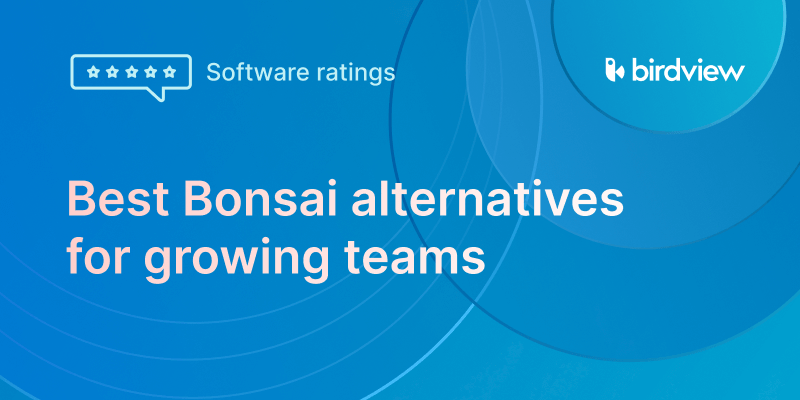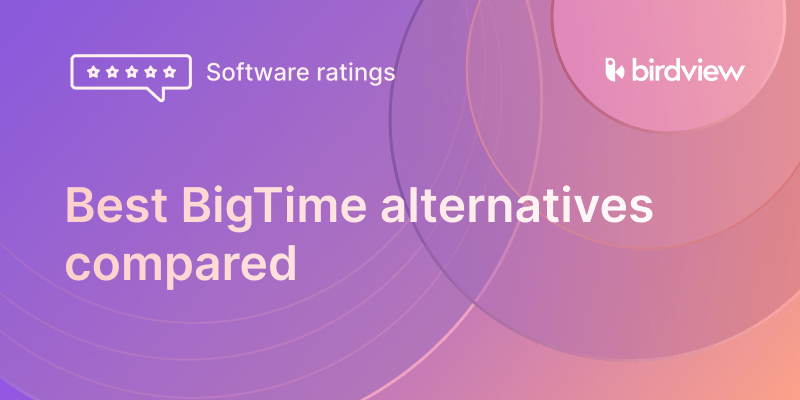Are you tired of juggling multiple tools and losing track of tasks? Does your team struggle with communication gaps and missed deadlines? Many teams face these common challenges, and the right work management software can be the solution.
However, there’s no need to let disorganization and inefficiency hold you back. We’re here to guide you through the best options available, tailored to address your specific pain points. In this article, we’ll explore the top work management software, highlight essential features, and provide practical tips for choosing the perfect tool for your team.
10 best work management software 2025
Birdview
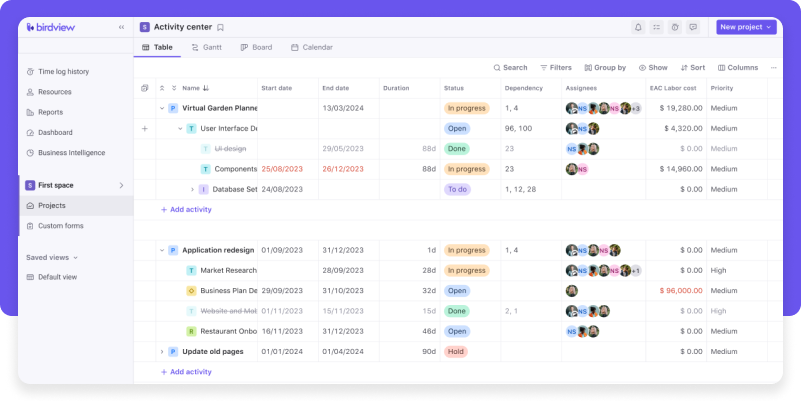
Birdview‘s work management software is designed to provide a comprehensive view of your project activities, resources, and finances. It combines robust project planning, resource management, and real-time collaboration tools in a single platform.
Birdview stands out for its ability to help teams maintain organization, boost productivity, and ensure that projects are completed on time and within budget. Its user-friendly interface caters to businesses of all sizes, from small startups to large enterprises. Birdview‘s advanced features enable detailed task management, precise resource allocation, and insightful reporting, making it easier for teams to track progress and make informed decisions. Additionally, its customization capabilities allow businesses to tailor the software to their specific workflows, ensuring it meets the unique needs of every team.
Features: task management, resource planning, time tracking, collaboration tools, budget and cost management, customizable dashboards, reporting and analytics.
Price: Starts at $9 per user per month for Birdview Project Management Lite license.
Trial: A free 14-day trial is available, possibly extending the trial period to 28 days. Sign up for a trial today to learn more about Birdview.
What users say
Pros:
Birdview has received positive feedback from users, particularly for its work management functionality. Users appreciate its ease of use and the ability to input and close out projects efficiently. The software‘s visibility features allow multiple members to see everyone‘s input and time, making collaboration smoother. Many users mention that they use Birdview multiple times a day, and its intuitive platform becomes easier to navigate with regular use.
Birdview‘s ease of segmenting different departments and teams using the “Spaces” feature is highlighted as a significant advantage, providing an organized and confidential way to manage projects. Users transitioning from other project management tools praise Birdview‘s work management software for its intuitive design and comprehensive project management capabilities, which simplify the management of large projects and personal tasks. The implementation process is straightforward, and continued support and maintenance are user-friendly, contributing to an overall great user experience. Users also commend the timely alerts, notifications, and excellent customer support that enhance the usability and efficiency of the platform.
Cons:
Despite the many benefits, users have noted a few areas where Birdview could improve. Some users find it inconvenient that higher credentials are required to add members to projects, even if they have super coordinator status. Users also note that the learning curve can be quite steep, and some aspects of the user interface are not as intuitive as expected, requiring more time to master the tool.
Monday
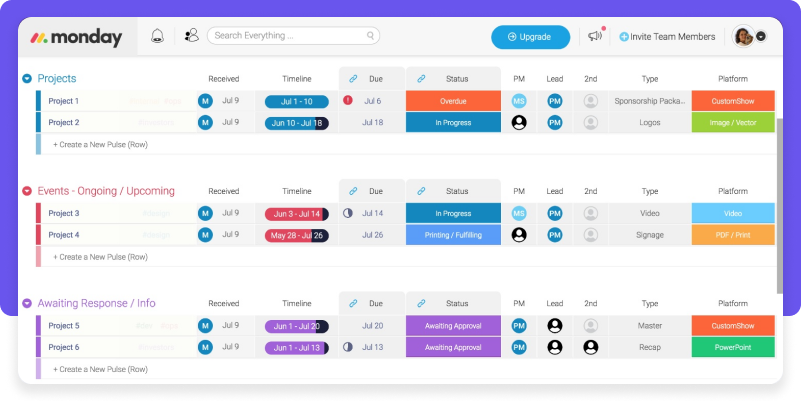
Monday.com is a work management platform that provides a visually intuitive platform, enabling teams to plan, collaborate, and track their tasks effectively. The platform‘s drag-and-drop interface combined with powerful automation features makes it perfect for teams aiming to enhance efficiency and streamline workflows. Offering a broad array of customizable templates, Monday.com supports various project types and workflows, significantly boosting team productivity and transparency.
Features: Task management, project tracking, collaboration tools, integrations, automation, time tracking, customizable templates.
Price: Starts at $9 per user per month for the Basic plan.
Trial: A free 14-day trial is available.
What users say
Pros:
Users appreciate Monday‘s intuitive interface that allows for easy segmentation of different departments and teams through the use of “Spaces,” facilitating organized and confidential project management. The platform’s flexibility in customizing dashboards to display projects by campaigns, events, and more is highly valued. Users also highlight the ease of monitoring team performance, profits, and individual contributions through customizable boards and forms. Many reviewers note that Monday.com has streamlined their workflow, making it easier to prioritize tasks and manage multiple projects efficiently. The platform’s robust integration capabilities and the ability to onboard new teams quickly are additional benefits that contribute to its popularity.
Cons:
Despite the many advantages, users have identified a few drawbacks with Monday‘s work management software. One common criticism is the steep learning curve associated with mastering the platform‘s full potential, particularly for advanced operations. Some users find the automatic filtering of new rows when working with saved filters frustrating, as it can cause new entries to disappear from view. Users also note that the pricing model may be less suitable for smaller firms with limited resources. Additionally, support interactions can sometimes be inconsistent, with users unable to stick with the same representative throughout their issue resolution. Lastly, while the platform offers many features, some users feel that setting up automations can be complex and that they occasionally malfunction without clear reasons.
Planview AgilePlace
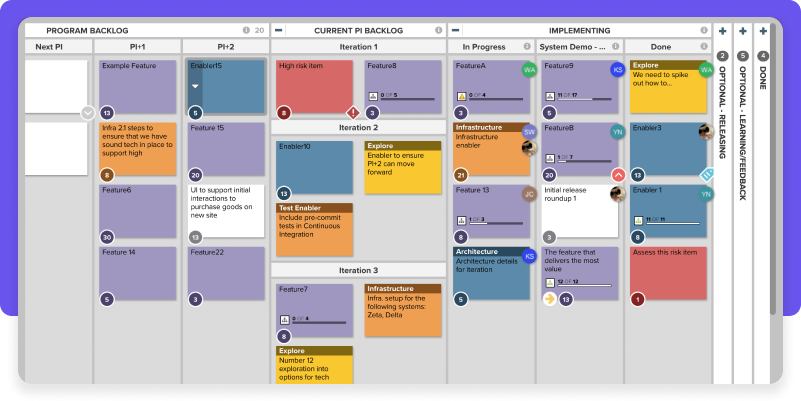
Planview AgilePlace (formerly known as LeanKit) is a visual project management tool that helps teams adopt agile methodologies and improve their workflows. It uses Kanban boards to visualize work processes, making it easier to manage tasks and projects effectively. AgilePlace supports teams in continuously improving their processes and delivering value more efficiently, making it ideal for organizations looking to implement agile practices.
Features: Kanban boards, task management, workflow automation, analytics, collaboration tools, backlog management, integrations.
Price: Pricing is available at request.
Trial: A free 30-day trial is available.
What users say
Pros:
Users like Planview AgilePlace for its performance and extensive integration capabilities with most project management-related tools. The platform prioritizes workflow and processing, simplifying the control of operational phases and enhancing traceability. Users find the application beneficial for generating intuitive reporting and analytical reports for numerous projects, which simplifies managing and tracking multiple projects. The customization options available allow users to tailor the tool to their demands and work styles, making it highly user-friendly. Features like dashboard customization according to priorities and departmental needs are particularly valued, enabling teams to track and manage resources and project activities effectively.
Cons:
Despite its strengths, users have identified a few areas where Planview AgilePlace could improve. One common criticism is its limited integration with the JIRA tool during test phases, which some users find restrictive. Additionally, the platform’s CRM and API tools can be challenging to use as work progresses, and it prevents updating or changing pre-planned workflow steps. The reporting and dashboard capabilities, while useful, are seen as lacking in-depth insights. Users would like to see more flexible card fields and improved import/export functionalities to avoid errors. Finally, while the user interface is generally well-received, some users feel it could benefit from enhanced flexibility and ease of customization, particularly in the reporting features.
Workfront
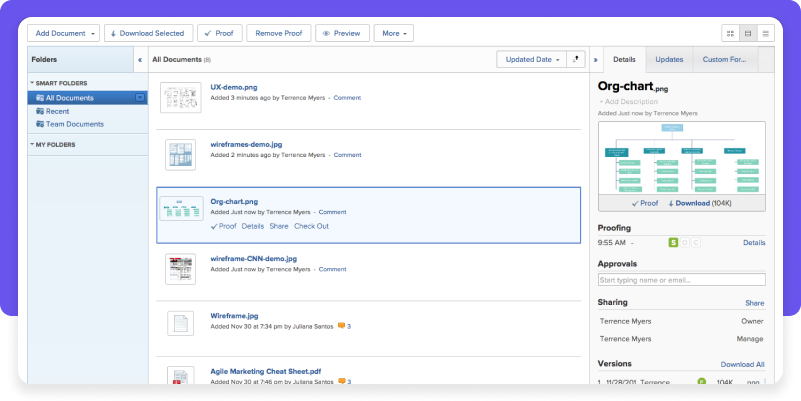
Workfront is an enterprise project and work management software that provides comprehensive tools for project planning, execution, and tracking. It offers work automation and collaboration features that help teams streamline their workflows and improve project delivery. Workfront is particularly well-suited for large organizations that need to manage complex projects and resources across multiple departments.
Features: Task management, project planning, time tracking, resource management, collaboration tools, reporting and analytics, integrations.
Price: Pricing is available at request.
Trial: A free 30-day trial is available.
What users say
Pros:
Users like the platform for its ability to merge tasks with dashboards, providing understandable and quantifiable metrics, which enhances project visibility and performance tracking. Workfront‘s flexibility in personalizing workflows and integrating with multiple tools makes it a versatile option for various project needs. The tool’s ability to analyze work time, predict project costs, and create analytical reports is seen as a major advantage. Additionally, users find the document management and visualization features to be very effective, facilitating smooth addition and processing of multiple data and documents. Many users also highlight the tracking features that allow administrators to monitor employee work status effectively.
Cons:
Users note that report generation can be challenging, especially when certain objects are not available or filters do not produce accurate results. Users also note that learning to navigate Workfront effectively can take months, and the multiple levels of documents, tasks, and folders can be confusing. Training new members is considered tricky due to the complexity of the platform. Another common complaint is the flood of email notifications, which can overwhelm users’ inboxes and make it difficult to sort important content. The training process, which relies heavily on self-guided recordings and question forums, is not well-received by all users, who prefer more direct support. Additionally, while the tool is praised for its project management capabilities, users would like to see more customization options for the user interface and dashboards.
Scoro
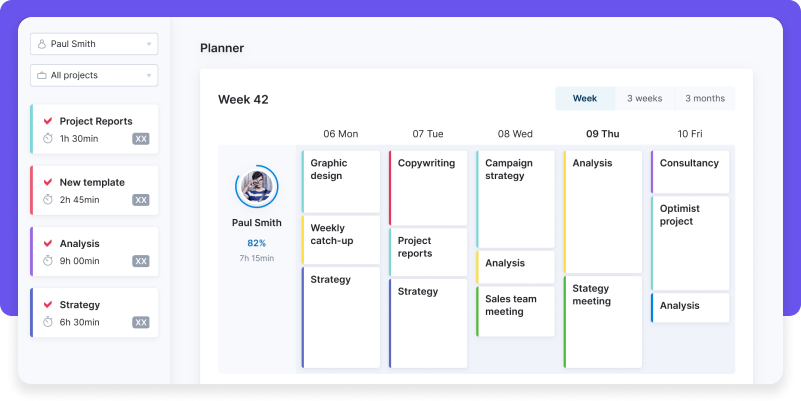
Scoro is an all-in-one work management software that integrates project management, CRM, billing, and reporting into one platform. It aims to streamline business processes and improve overall efficiency by providing a comprehensive set of tools. Scoro is ideal for professional service firms and agencies looking to manage their entire business operations from a single platform.
Features: Task management, CRM, billing and invoicing, time tracking, financial reporting, calendar, integrations.
Price: Starts at $26 per user per month for the Essential plan.
Trial: A free 14-day trial is available.
What users say
Pros:
Users appreciate Scoro‘s customizable views, which enhance the accuracy of assessing assignments and provide a quick overview of team productivity through the timesheet functionality. Scoro’s ability to customize views for teams, projects, or individual tasks is invaluable, allowing users to revisit past projects and add new tasks for updates, leveraging historical data for decision-making. The integration between tasks, projects, and quotes simplifies workflows, making it easy to match clients to quotes and access past job details. Many users note that the software’s advanced features and user-friendly interface make it a comprehensive tool for managing daily tasks and high-volume operations.
Cons:
While Scoro offers many benefits, users have identified a few challenges. Initial setup can be daunting due to the extensive customizations required, although this is mitigated by effective onboarding support. The software’s learning curve is steep, requiring training to fully utilize its features, especially for new users. Some users have encountered occasional slowness when opening projects with a lot of details, affecting team efficiency. Additionally, reporting features could be more customizable to meet specific needs. Finally, during the initial setup stage, migrating old information into the system can be a significant task that requires careful planning, especially under time constraints.
Screendragon
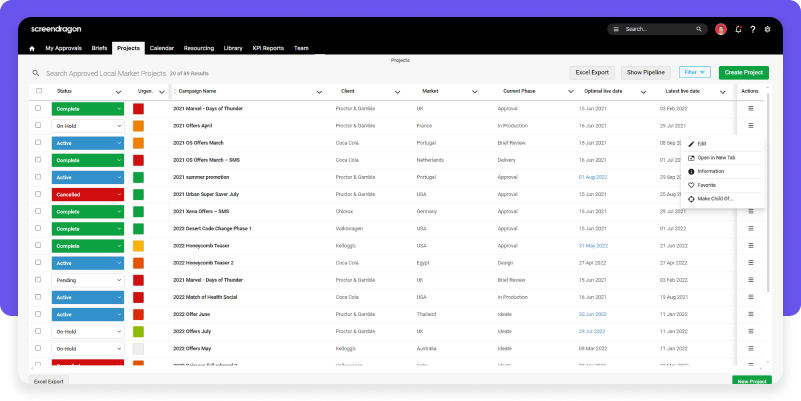
Screendragon is work management software designed for marketing, creative, and professional services teams. It offers powerful project management tools combined with advanced workflow automation and resource management capabilities. Screendragon’s highly customizable and user-friendly interface helps teams deliver projects faster and more efficiently.
Features: Task management, resource planning, workflow automation, collaboration tools, project templates, budget tracking, reporting and analytics.
Price: Pricing is available at request.
Trial: A free 14-day trial is available.
What users say
Pros:
Screendragon is appreciated for its flexibility and customizability, which allow it to centralize working practices at a global level while also accommodating local requirements. Users highlight the platform’s ability to streamline complex workflows and reduce unnecessary administrative tasks, thus enabling teams to focus on quality work. The platform’s comprehensive configuration options make it suitable for project managers, finance teams, and resource managers, providing just the right amount of detail without overwhelming medium-sized organizations. Additionally, the team at Screendragon is praised for being responsive and supportive, helping users navigate through the complexities of setup and customization. Users also value the tool’s capacity to consolidate various systems and workflows into one platform, enhancing overall operational efficiency.
Cons:
However, users note that the initial setup can be challenging due to the extensive customization required, but this is often mitigated by effective support from the Screendragon team. Some users find the design could be sleeker, though they acknowledge that functionality compensates for this aesthetic shortfall. The platform can sometimes be slow, particularly when dealing with complex projects or multiple columns, which may impact team efficiency. Some users also mention that the extensive features can lead to confusion, especially when not all advanced options are utilized. The learning curve can be steep, requiring substantial training to fully leverage the tool’s capabilities. Lastly, while the tool’s vast configuration options are generally seen as a benefit, they can sometimes make the system appear overly complex for simple use cases.
Redbooth
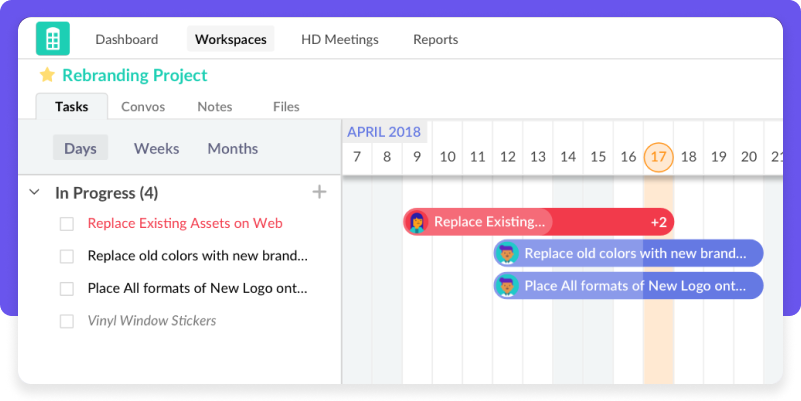
Redbooth is a tool designed for project management and team collaboration. It features an intuitive interface with easy-to-use tools for task management and communication, making it perfect for organizing work and boosting productivity. Ideal for small to medium-sized teams, Redbooth provides a simple solution to manage projects and improve teamwork efficiently.
Features: Task management, Kanban boards, time tracking, file sharing, HD video meetings, project templates, reporting.
Price: Starts at $9 per user per month for the PRO plan.
Trial: A free 14-day trial is available.
What users say
Pros:
Redbooth‘s work management software is favored for its user-friendly interface and robust task management capabilities. Users find it easy to assign tasks, track progress, and prioritize work with various tags, which makes team collaboration efficient and organized. The platform’s ability to store all project files and serve as a backup is particularly valued, providing a central location for all important documents. Users also highlight the convenience of creating different workspaces for various teams and departments, facilitating better organization and collaboration. The dashboard, which resembles an email interface, makes it easy for users to check tasks and updates. Overall, Redbooth has had a positive impact on performance, helping teams maintain balance and achieve more on a daily basis.
Cons:
Users note that the mobile application has room for improvement, as it takes up a lot of storage space and lacks robust support, with poor text drafting capabilities. Users also mention occasional crashes and minimal customer support as areas needing enhancement. The file storage capacity is limited to 2GB, which can be restrictive for teams handling large amounts of data. These issues, while significant, do not overshadow the overall positive feedback, but they do suggest areas where Redbooth could improve to better meet user needs.
Wrike
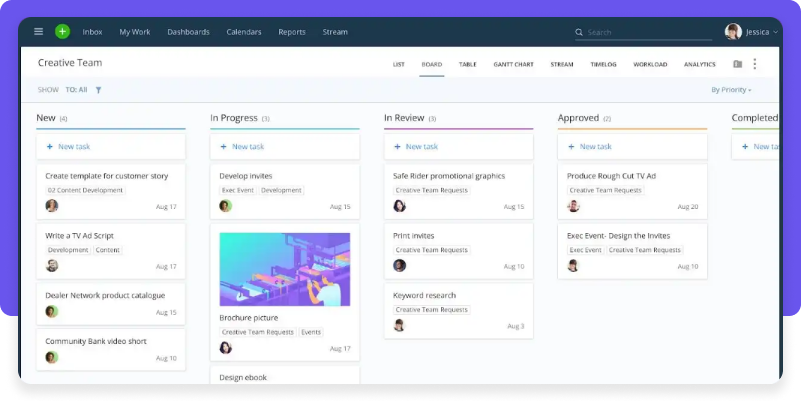
Wrike is a project management software that helps teams collaborate, manage tasks, and track project progress. It offers a range of features to support various project management methodologies, including agile and waterfall. Wrike‘s customizable dashboards, powerful integrations, and real-time collaboration tools make it a great choice for teams of all sizes.
Features: Task management, project planning, time tracking, Gantt charts, collaboration tools, custom workflows, reporting and analytics.
Price: Starts at $9.80 per user per month for the Team plan.
Trial: A free 14-day trial is available.
What users say
Pros:
Many users highlight Wrike‘s ability to create custom items, set automation rules, and view tasks in multiple formats (such as table view and Kanban boards) as key benefits. Wrike’s frequent feature updates, often aligning with user feedback, keep the platform dynamic and responsive to user needs. Users also appreciate the excellent customer success and support teams, which help ensure a smooth implementation and ongoing use. The platform has significantly improved visibility into work across the business, automated a lot of manual processes, standardized workflows, and enabled the collection of granular project-level data for client-facing reporting. The customizability of workflows and the ability to perform complex automations quickly are also highly valued, making Wrike a powerful tool for diverse project management needs.
Cons:
Users note that the platform is not the easiest to learn due to its extensive flexibility, often requiring a dedicated team to configure and implement it successfully. Users also mention that email notifications can be overwhelming and suggest improvements to manage them better. Another common issue is the difficulty in keeping oneself as a follower on tasks after reassigning them, which can lead to missed updates. The complexity of deciding when to use projects versus tasks in custom workflows adds to the learning curve. Initial rollout guidance could also be improved to prevent fragmented usage and reduce the need for later consolidation and change management.
Accelo
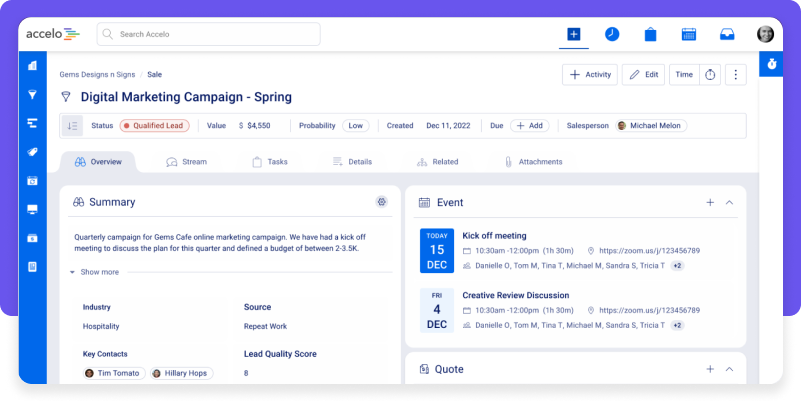
Accelo is a work management software specifically designed for service businesses. It integrates project management, CRM, time tracking, and billing into one platform, helping businesses streamline their operations and improve client management. Accelo is ideal for professional service firms looking to automate their workflows and enhance client relationships.
Features: Task management, CRM, time tracking, billing and invoicing, project planning, client portal, reporting and analytics.
Price: Pricing is available at request.
Trial: A free 14-day trial is available.
What users say
Pros:
Accelo is valued by users for its ability to integrate various business functions such as sales, project management, service calls, and billing into one cohesive platform. This integration is particularly beneficial for growing companies, allowing them to manage everything from full-time office staff to field technicians efficiently. Users appreciate the seamless onboarding process, minimal learning curve, and the platform’s flexibility to grow with their business. The platform is favored for its ability to centralize all project-related information, making it easy to manage client emails, files, appointments, and notes, all of which can be accessed from any device. The ability to automate operations and gain visibility into various business processes has also been highlighted as a major benefit. Accelo‘s feature to convert quotes directly into projects and its comprehensive invoicing options are particularly appreciated. Users also like the platform’s support team for their quick and helpful responses, making it easier to navigate and implement the system effectively.
Cons:
Despite its many benefits, the mobile app is considered the weakest point, with limited functionality compared to the web portal, particularly from a management perspective. Some users also find the pricing model for small businesses could be more accommodating. The variety of date options (planned, scheduled, predicted, actual) can be confusing for users, complicating project management. Additionally, issues with tracking hours in retainer periods have been noted, where hours may be assigned to old periods even if the dates don’t match. Some users have found that certain Accelo modules, such as day-to-day status tracking and Gantt charts, do not perform as effectively as promised, leading them to supplement with other tools like Jira for daily task tracking.
Hive
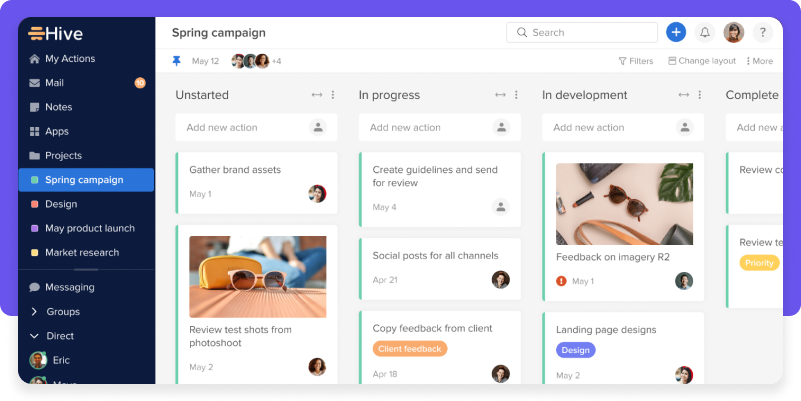
Hive is a project management and collaboration platform designed to boost efficiency and accelerate workflows. It integrates task management, project tracking, and communication tools within a single interface, ensuring teams remain organized and productive. With robust analytics and adaptable project views like Gantt charts and Kanban boards, Hive empowers teams to visualize progress clearly and make informed, data-driven decisions.
Features: Task management, project tracking, messaging, file sharing, time tracking, workflow automation, integrations.
Price: Starts at $6 per user per month for the Team plan.
Trial: A free 14-day trial is available.
What users say
Pros:
Many users highlight how Hive‘s work management software allows them to manage multiple projects simultaneously, each with its own workspace, while also providing an overview of all projects at a glance. This is particularly useful for keeping track of progress and assigning workflow statuses to individual tasks. Users appreciate the platform’s ability to consolidate project management into one neat package, making it easy to see both the broader project status and more granular details. The ability to share project Gantt views externally without additional licensing is especially beneficial for keeping clients updated. Additionally, the excellent support and responsiveness to feature requests foster a positive user experience, ensuring that Hive evolves in line with user needs.
Cons:
Some users mention an initial learning curve due to differences from other project management tools, though this is mitigated by helpful support. Occasional UI glitches, particularly when viewing multiple columns in the desktop application, can be frustrating, though they are often resolved by reloading the window. Additionally, some users find the frequent introduction of new features and UI changes can make it challenging to locate previously known functions. There are also occasional glitches that cause the app to shift within the window, necessitating a computer restart to fix the issue.
Key work management software features to look for
Choosing the right work management software can transform your team’s productivity and efficiency. To help you make an informed decision, let’s delve into the essential features you should look for. These features are designed to address common pain points and streamline your workflow, ensuring your team can collaborate effectively and stay on top of their tasks. We’ll use Birdview as an example to illustrate how these features can benefit your team.
- Task management
Efficiently assign, track, and manage tasks to ensure nothing falls through the cracks. Birdview allows you to create detailed task lists, set priorities, and assign responsibilities to team members. The software‘s intuitive interface makes it easy to update task statuses and monitor progress in real time, reducing the chances of missed deadlines. This feature helps keep everyone on the same page, ensuring that tasks are completed on time and to standard.
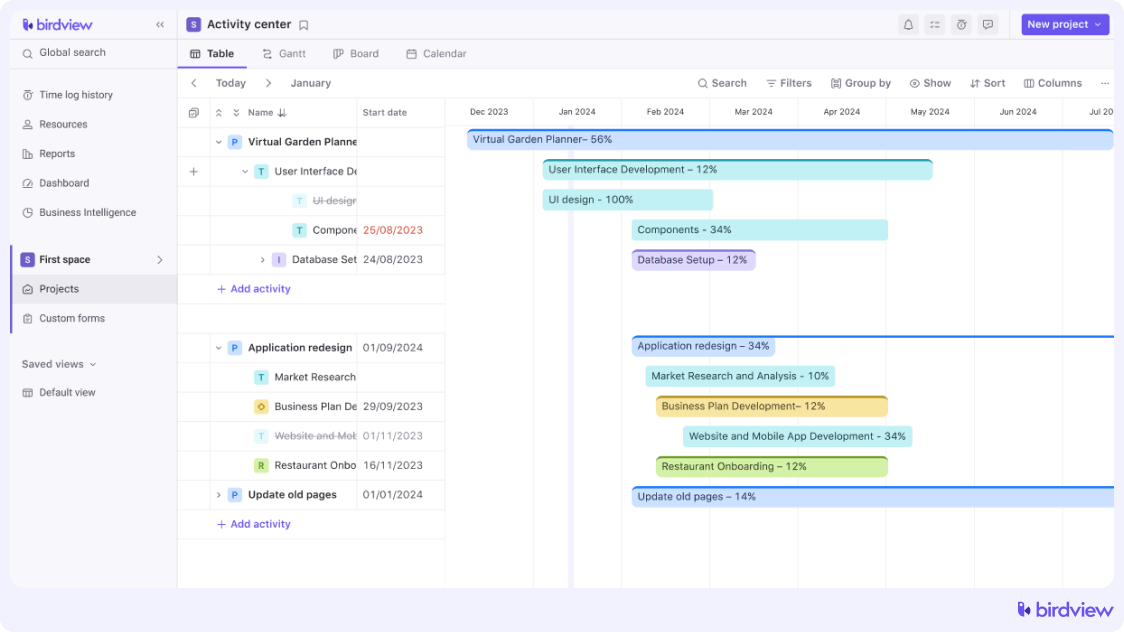
- Collaboration tools
Facilitate seamless communication and collaboration among team members. Birdview offers robust tools such as chat, file sharing, and real-time document editing. These features ensure that all team members can quickly share ideas, provide feedback, and work together effectively, no matter where they are located. This reduces miscommunication and keeps the workflow smooth and productive.
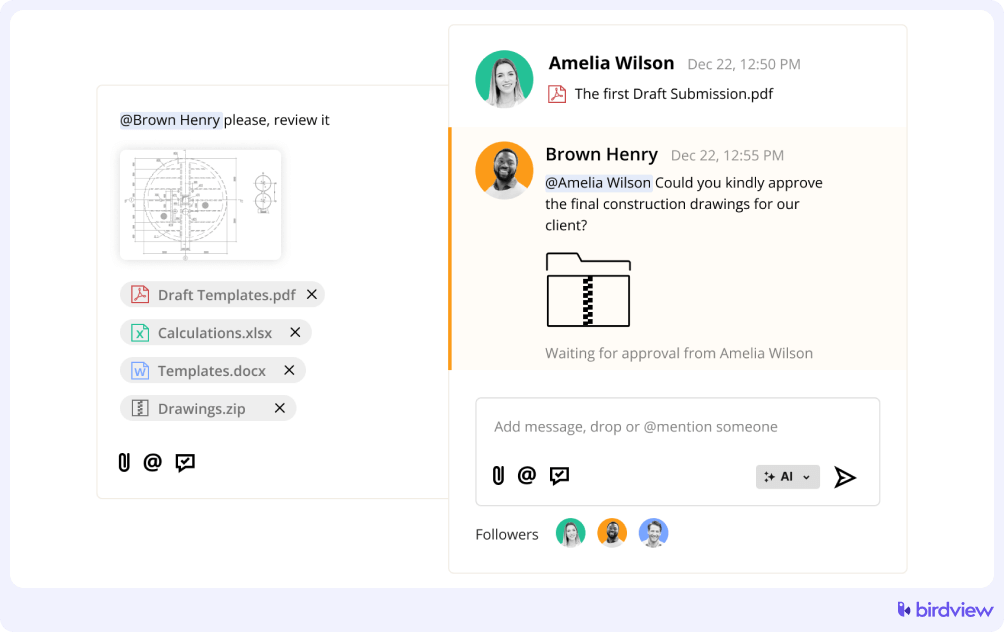
- Resource planning and scheduling
Efficiently manage your team‘s resources and schedules to maximize productivity. Birdview allows you to allocate resources based on availability, skill sets, and project requirements. The work management software provides a clear overview of resource utilization, helping you avoid overbooking or underutilizing your team members. This ensures a well-balanced workload, enhancing productivity and preventing burnout.
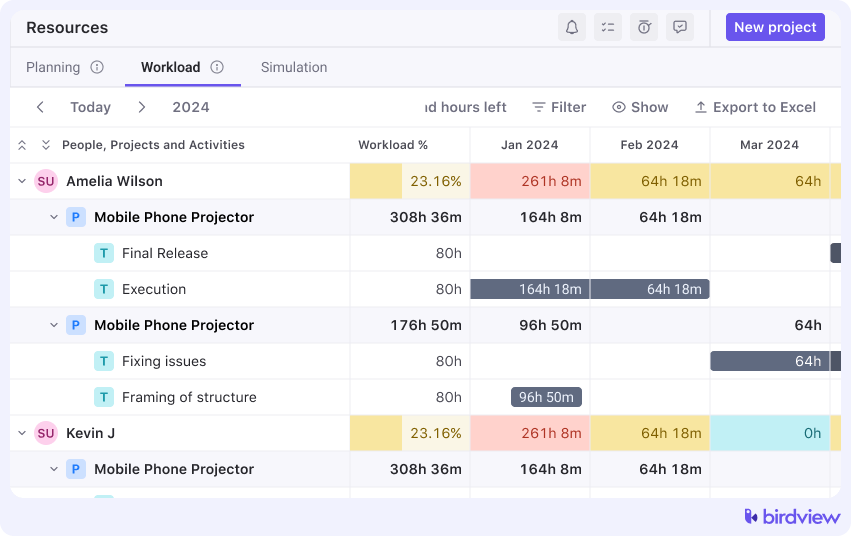
- Budget and cost management
Keep track of project finances to maintain financial control and project success. Birdview‘s budget and cost management tools allow you to set budgets, monitor expenses, and generate financial reports. This feature helps you stay within budget, identify cost-saving opportunities, and make informed financial decisions, ensuring your projects are financially viable.
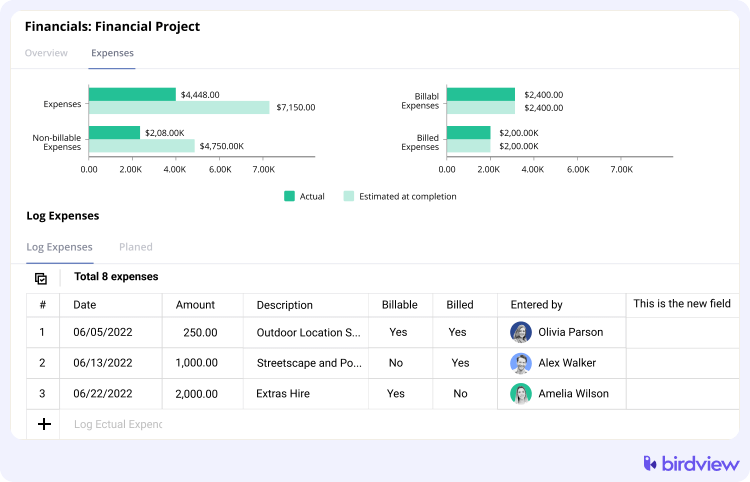
- Portfolio management
Managing multiple projects can be challenging without a clear overview. Birdview‘s portfolio management features provide a high-level view of all your projects, allowing you to prioritize and align them with your business objectives. The software helps you track the progress of each project, allocate resources effectively, and make strategic decisions. This comprehensive view of your project portfolio helps you manage priorities and drive overall success.
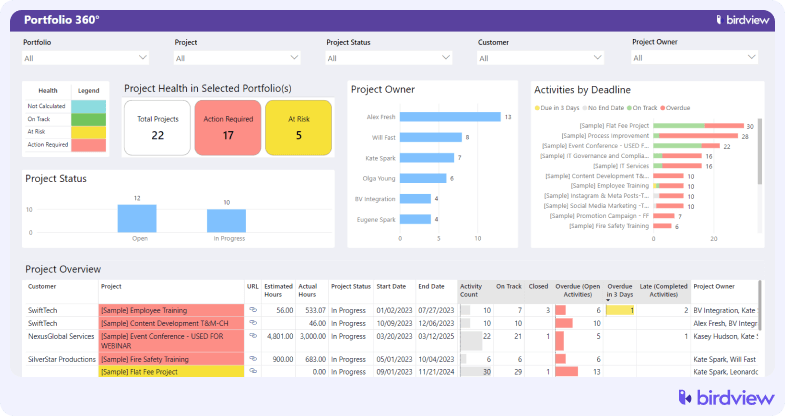
- Time tracking
Keeping track of how time is spent on tasks and projects is crucial for improving productivity and accountability. Birdview‘s integrated time-tracking tools allow you to log hours directly into tasks, generate timesheets, and analyze how time is utilized across different projects. This helps identify bottlenecks and optimize resource allocation, ensuring that your team is working efficiently and staying on schedule.
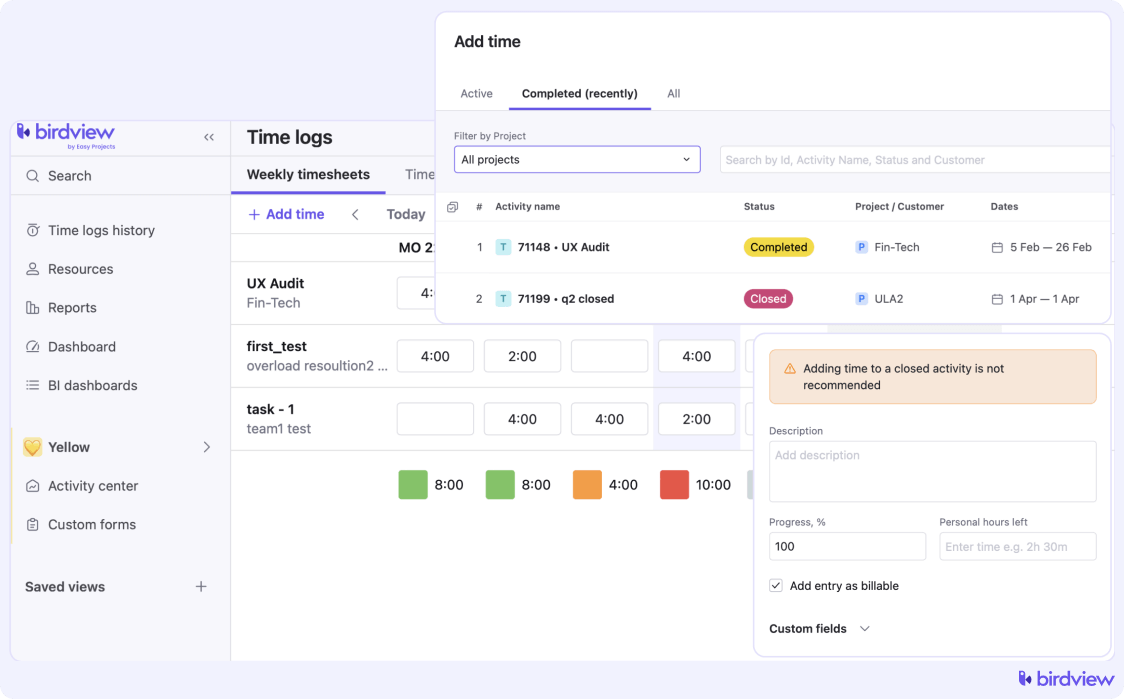
- Reporting and analytics
Look for work management software that offers customizable dashboards, detailed reports on task and project progress, time-tracking analytics, and resource utilization metrics. Birdview‘s advanced reporting module includes all of these features to provide you with a clear view of key metrics and performance indicators. This data-driven approach helps in planning and forecasting future projects more accurately, allowing you to make informed decisions and improve overall project management.
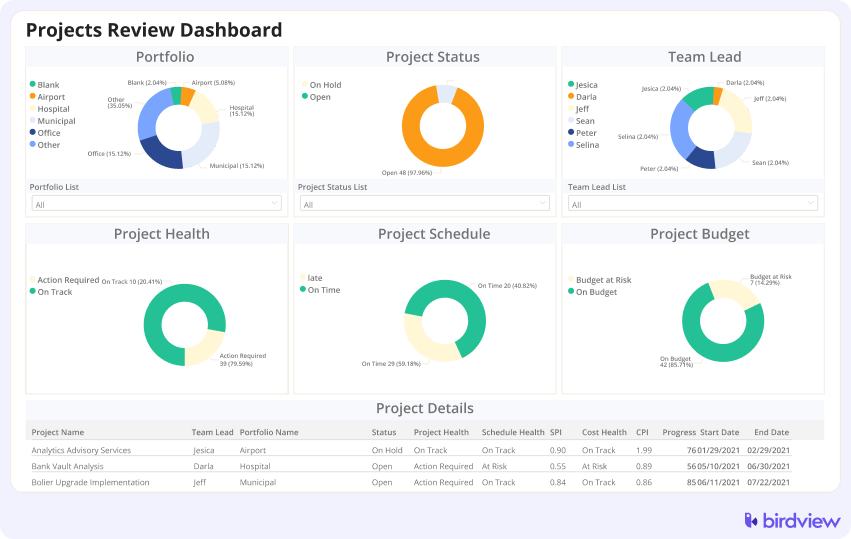
- Integration capabilities
Ensure the software can integrate with other tools your team uses for a cohesive workflow. Birdview excels in this area with its wide range of integrations, including email platforms, calendar apps, and other productivity tools. This seamless connectivity helps maintain a unified workflow, saving time and reducing errors by keeping all your tools connected and working together.
- Customization options
The ability to tailor the software to fit your team’s specific workflows and preferences is crucial. Birdview offers extensive customization options, allowing you to create custom fields, workflows, and dashboards. This adaptability ensures that the work management software aligns perfectly with your team‘s unique processes, enhancing overall efficiency and making the tool an integral part of your daily operations.
9 Advantages of Online Project & Task Management Software
How to finish a project on time and within budget
How to choose the right work management software for your team
Selecting the right work management software is a critical decision that can significantly impact your team’s productivity and efficiency. With so many options available, it’s important to choose a tool that not only addresses these pain points but also grows with your team and adapts to future challenges.
The right software should streamline your workflow, improve communication, and provide valuable insights into your projects. Below, we’ll provide detailed tips on how to choose the right work management software for your team, ensuring you make an informed decision that will enhance your team’s performance and satisfaction.
1. Assess your team’s needs
Start by evaluating the size of your team, the complexity of your projects, and the specific challenges you face. Make a list of essential features based on these needs. For instance, if your team struggles with task tracking and communication, look for software that offers robust task management and collaboration tools. This will provide the structure and connectivity you need to stay on top of your work and ensure everyone is aligned.
2. Set a budget
Determine how much you’re willing to spend on work management software. There are excellent options available for various budgets, from free tools to premium solutions. Consider what features are most important to you and ensure that the plan you choose provides the best value for your investment. This will help you avoid overspending while still getting a tool that meets your needs.
3. Trial and test
Take advantage of free trials or demos to test out the software with your team. Pay attention to user-friendliness and how well it fits into your existing workflow. Use this time to gather feedback from your team on its ease of use and effectiveness in addressing your pain points. This hands-on experience is invaluable in making a confident decision, ensuring the software you choose is a good fit for your team.
4. Read reviews and testimonials
Look for feedback from other users, especially those in similar industries or with similar needs. This can provide valuable insights into the software’s strengths and weaknesses. Reading reviews can give you a better understanding of how the software has helped other teams overcome similar challenges and achieve their goals. This will help you identify potential issues and benefits before making a commitment.
5. Consider scalability
Choose a solution that can grow with your team. Ensure it can handle increased workload and additional team members as your business expands. Look for software that is designed to scale, offering features that support both small teams and larger organizations. As your projects and team grow, the software should be able to accommodate more users, projects, and complex workflows, ensuring it remains a valuable tool as your needs evolve.
6. Support and training
Check the availability of customer support and training resources. Good support can make a significant difference in the successful implementation of the software. Look for software that provides excellent customer support and a wealth of training resources, including tutorials, webinars, and a dedicated support team. This will ensure that you and your team can quickly get up to speed and address any issues that arise, making the transition smoother and more effective.
Benefits of work management software
Work management software is designed to address these pain points, transforming the way your team operates. By implementing the right tool, you can streamline your processes, enhance collaboration, and ensure that everyone stays focused and productive. Here are the key benefits of using work management software and how they can directly alleviate your team’s struggles.
- Improved organization
Keeping all tasks, projects, and communications in one place can significantly reduce the chaos. Work management software provides a centralized platform where you can organize everything efficiently. Imagine having a clear, organized view of all your tasks, deadlines, and communications, making it easier to stay focused and on track. No more hunting through emails or disparate tools to find the information you need.
- Enhanced productivity
Automating repetitive tasks and streamlining workflows can free up your team’s time for more important work. Work management software can automate routine processes, reducing the time spent on administrative tasks. Think about how much more your team could accomplish if they weren’t bogged down by manual data entry and could instead focus on high-value activities. This leads to a significant boost in overall productivity.
- Better collaboration
Effective teamwork relies on strong communication and collaboration. Work management software provides essential tools for real-time interaction, including chat, file sharing, and document editing. These features help ensure all team members are aligned, minimizing miscommunications and enhancing overall collaboration.
- Increased accountability
Clear task assignments and deadlines help ensure everyone knows their responsibilities and stays accountable. Work management software allows you to assign tasks, set deadlines, and track progress. This transparency ensures that everyone knows what is expected of them and when. Imagine the peace of mind that comes with knowing that tasks are being tracked and that there is a clear record of who is responsible for what.
- Informed decision-making
Data-driven decisions are the key to improving team performance and project progress. Work management software offers detailed reports and analytics, providing clear insights into key metrics and performance indicators. This valuable information helps you make informed decisions based on your team’s performance and project data. Think about having the ability to quickly identify bottlenecks, measure productivity, and forecast future projects accurately. This data-driven approach allows you to make informed decisions that drive success.
Work management software FAQs
Q: Is work management software suitable for small businesses?
A: Yes, many work management tools are scalable and can be tailored to fit the needs of small businesses. They can help improve organization, productivity, and collaboration, regardless of team size.
Q: How secure is work management software?
A: Security varies by software, but reputable work management tools offer robust security measures, including data encryption, secure access controls, and regular security updates.
Q: How easy is it to implement work management software?
A: Implementation ease varies, but many work management tools offer user-friendly interfaces, detailed onboarding processes, and customer support to help with the setup. Free trials and demos can also assist in assessing how easily the software can be integrated into your team’s workflow.
Q: What is the difference between work management software and project management software?
A: Work management software focuses on managing day-to-day tasks, team collaboration, and ongoing workflows across various projects. It is designed to improve overall team productivity and efficiency. Project management software, on the other hand, is typically more focused on planning, executing, and closing specific projects, often with features for project timelines, milestones, and deliverables. While both types of software overlap in functionality, work management software is generally broader and more focused on continuous work processes, whereas project management software is more specialized for handling distinct projects.

